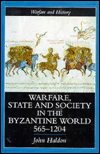

 |

|

The average rating for Warfare, State, and Society in the Byzantine World, 565-1204 based on 2 reviews is 4.5 stars.
Review # 1 was written on 2021-03-01 00:00:00 Raymond John Manogue Jr Raymond John Manogue JrThis is a very interesting and well written book. Although it covers 650 years, it can be divided into four periods. Up to the creation of the Thematic Army, which isn't that well served. The Thematic Army. The offensive Army. The Comnenus Army, which, again, isn't that detailed. Although there are a few facts that are repeated, this is a book that is easy to read. It's also very informative, covering everything you could imagine, short of actual campaign history regarding which force went where and when. As a scholar of Anglo-Saxon England, learning about the struggles of Byzantium regarding supporting their armed forces, it does add force to the arguments of smaller forces being effectively available to the Anglo-Saxons and the Viking invaders. It's hard to imagine anyone topping this book for many years to come. |
Review # 2 was written on 2017-01-24 00:00:00 Jonathan Bierner Jonathan BiernerWithout a doubt, this is the absolute standard military history of Byzantium, and probably will be for many years to come. Although I would consider this to be a military history, it is not one in the traditional sense. It is not a chronological run through of Byzantine history with an emphasis on military events. Rather, each chapter focuses on a particular theme, and then Dr. Haldon goes to show how this changed over time. If you're just looking for a general military history with a focus on tactics, equipment and battles, I recommend this book's companion volume, The Byzantine Wars. As the title suggests, this is a study primarily focused on how warfare related to society in East Rome. I'm just going to give a brief summary of each chapter. The first chapter deals with attitudes to warfare in East Rome, and finally puts that debate to bed. It is excellent, and examines the religious issues surrounding warfare, especially in light of the traditional views and Basil of Caesarea, and how we cannot apply the concept of 'holy war' to them, but that the Byzantine attitudes really need their own category. The second chapter deals with geography, and this one is exceptional. Geography and logistics are a specialty of Dr. Haldon's, and it really shows here. It is loaded with great maps, and deals primarily with how geography related to strategy, as well as the difficulties it created in waging any sort of military campaign. The third chapter deals primarily with organizational systems, and how the late Roman army became the thematic army. While the description far surpasses any that I have read to date, it does feel like Dr. Haldon is withholding a lot of information, especially considering his lengthy bibliography on the topic of middle Byzantine military organization. Although this particular topic could occupy several books, it is a shame that this chapter isn't another 50 pages longer or so. However, given its readability and how succinct of a summary that it is, it would be unreasonable to fault Dr. Haldon for not turning that one chapter into a book on its own. The following chapter continues the evolution of the army, but focuses instead on equipment, recruitment and tactical organization, providing a well-rounded and balanced picture of the army's evolution. The fifth and sixth chapters make up the bulk of the middle of the book, and deal with the army at war, the first on campaign, and the second on combat. The campaign section deals with camps, logistics and marching orders, while the combat section discusses the actual experience of battle, something that we do not know a whole lot about. The final chapter deals with the issues surrounding the status of soldiers, and how they behaved in society, and is quite revealing, as it uses often-obscure hagiographical evidence. The book closes with a brief concluding chapter and three appendices that all discuss logistics, and how we can calculate the amounts of food needed for soldiers and pack animals using the Law of Diminishing Returns. Although this system seems largely based upon Engel's study of the supply of Alexander the Great's army, it is nonetheless updated, interesting and useful. This is an excellent history of how warfare relates to the Byzantine state and society. It is an essential read for any discussion of the Byzantine military, and now that it is in paperback, this important academic work is now affordable. If it has one problem, it is the use of endnotes. Haldon's notes are good, but would have served the text much better as footnotes, as one has to flip back and forth constantly. However, given the quality of work contained within, this is a minor complaint. This book is important for anyone interested in Byzantine warfare, and essential reading for any serious study of the topic. |
CAN'T FIND WHAT YOU'RE LOOKING FOR? CLICK HERE!!!